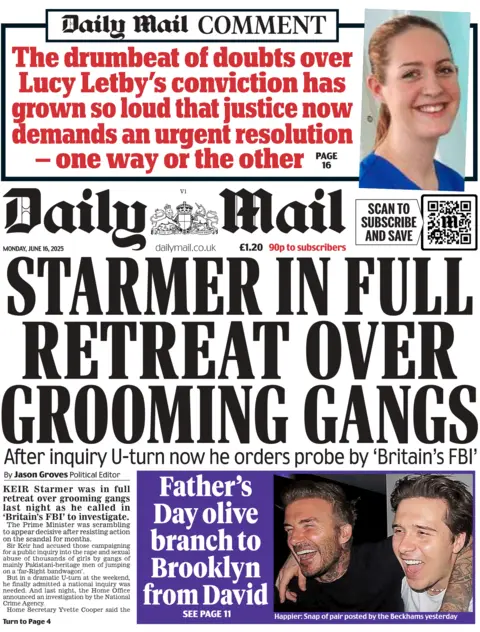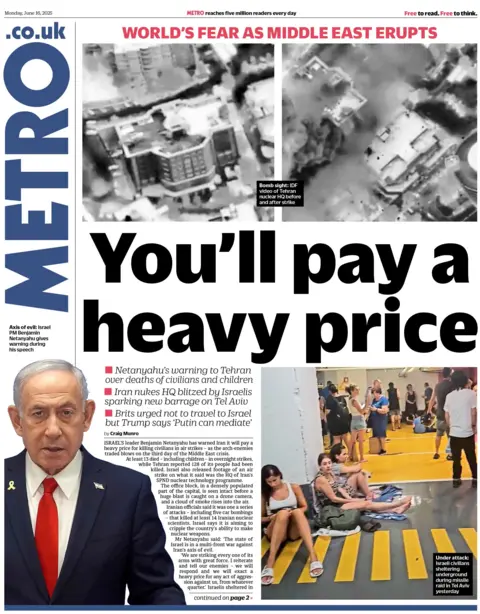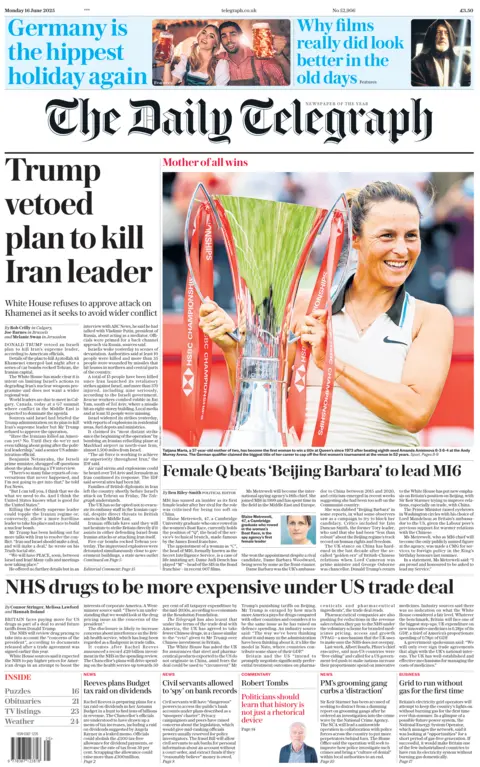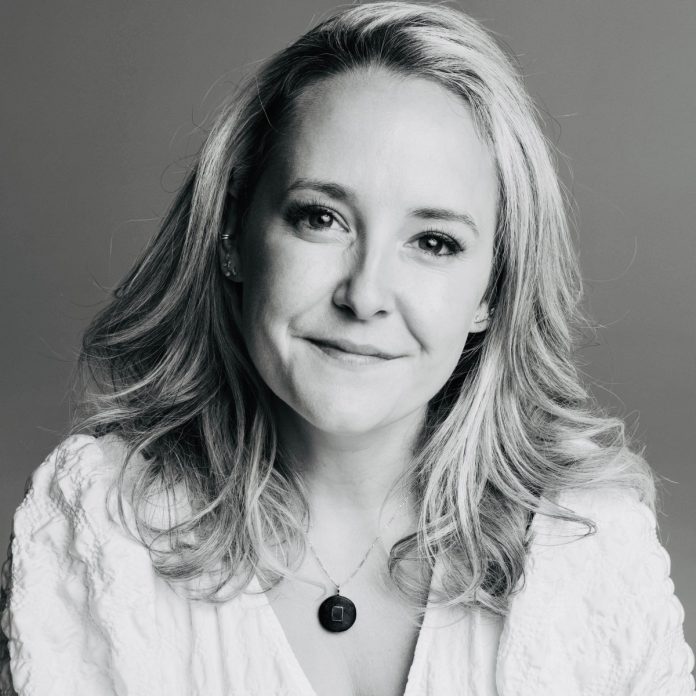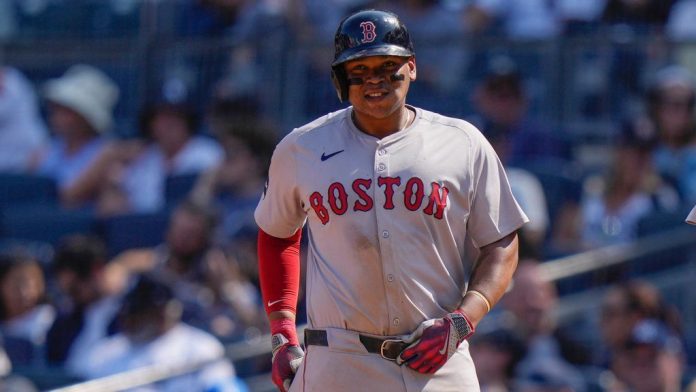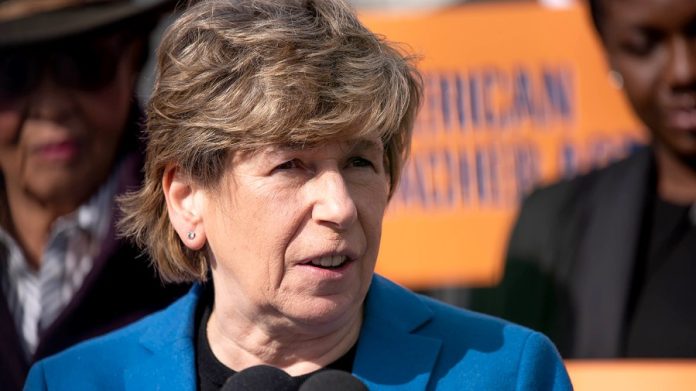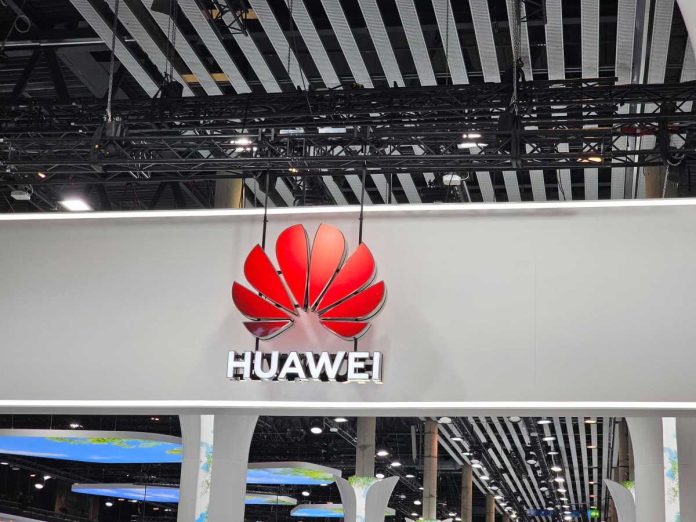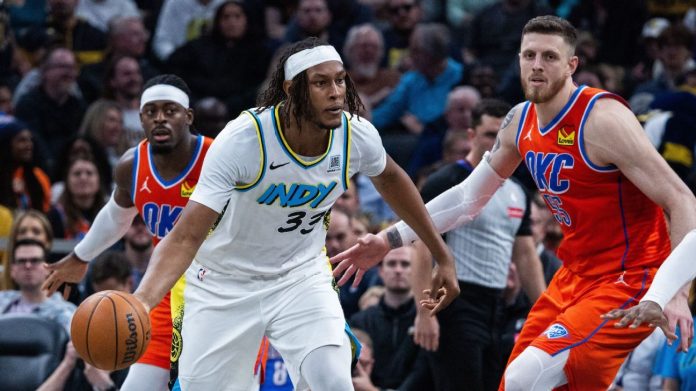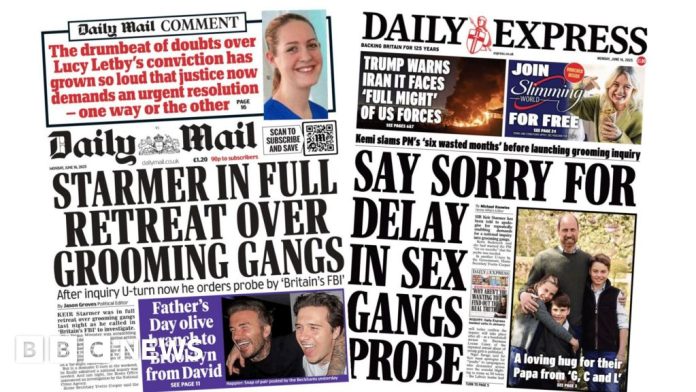Trump Disclosure Shows $57 Million in Earnings From Early Crypto Push
Trump Disclosure Shows $57 Million in Earnings From Early Crypto Push
Alexa von Tobel has high hopes for ‘fintech 3.0’
It’s been 10 years since Alexa von Tobel sold her financial planning startup LearnVest to Northwestern Mutual for a reported $375 million.
Since then, von Tobel became Northwestern Mutual’s first chief digital officer, then chief innovation officer, before launching an early-stage venture firm of her own, Inspired Capital, with former U.S. Secretary of Commerce Penny Pritzker. She’s also a New York Times bestelling author, and she’s about to launch a new interview podcast, “Inspired with Alexa von Tobel.”
In a conversation with TechCrunch, von Tobel recalled the hectic period around the acquisition, which closed literally days before the birth of her first child, and when she knew it was time to start her own firm.
Von Tobel explained that she created Inspired to be the investor she’d dreamed of — one with a “cultish commitment to entrepreneurship” — when she was a founder herself. And while Inspired is a generalist firm, she said she feels both “urgent and optimistic” about fintech, the sector where she launched her career. (One of her pre-Inspired fintech investments, Chime, just went public.)
“We think of this wave as fintech 3.0,” von Tobel said. “The next wave of innovation won’t come from superficial tweaks but from fundamental deep product reinvention — tools that meet the needs of a changing economy and a more diverse, digitally native population.”
The following interview has been edited for length and clarity.
Congratulations on the 10-year anniversary of the acquisition. Looking back, what do you feel proudest of?
First, Northwestern Mutual is an incredible company, and our software became an incredibly important part of the customer experience. And I am so proud that so many of the LearnVest team stayed at Northwestern Mutual for so long, and it really was just a merger of actual values. It’s just amazing how simple some things are, it comes down to the values of two companies and the missions of two companies.
I sold on a Wednesday and went into labor with my first child that weekend. All jokes aside, I always say it took me about a year to mentally just recover from being, like, all systems were go, my brain was being pushed to manage so many things. Literally, I was having my first child. It was like the world threw a bus at me and I caught it.
So when you were closing the deal, was there a ticking clock in your mind, that you had to finish everything before this whole other thing happens?
Of course. If you think about it, we literally signed on, I think, 11am on March 25 and then we did a press tour with the CEO, and then the next day, we did a stand up with the entire team, and then I went to sleep and literally woke up in labor.
Having your first child is priceless. There’s nothing in the world that is more valuable to me than having my children, nothing. And so I kept being like, “We have to get this done, because I’m not leaving the hospital to come back and close a deal. I actually need to focus on this human being that I’m bringing into the world.” I always joke that the lawyers took me very seriously.
When people on the outside talk about an acquisition, obviously, the first thing they talk about is usually the financials, and then one of the signs of success is the product. LearnVest as a product doesn’t exist anymore, but it sounds like it was less about having LearnVest as a standalone product and more about transforming Northwestern Mutual.
It was so much bigger than a product. [Northwestern Mutual’s] John Schlifske, he’s no longer CEO, but he is one of the people I look up to most in the world, just a formidable human being. And he kept being like, “We’re gonna merge the companies.” And I would laugh — one is a $40-billion-a-year company, and [the other is] little tiny LearnVest. But he really meant it. He was like, “We’re gonna use this as a catalyst.” It was a catalyst for an entire digital transformation.
I became the company’s first ever chief digital officer, and then chief innovation officer, and it was really about taking everything and merging it into the broader parent company. My CTO of LearnVest became the CTO of the parent company.
You stayed for four years?
Yeah, [my last day] was basically end of January 2019, and that day we launched Inspired.
How did you know it was time to leave, and where did the idea for Inspired come from?
I’m always at my best when I’m building something that I wish existed for me. And I’ve said many times that the idea for Inspired actually happened when I dropped out of business school, and I was a really all-in entrepreneur in every way — I dropped out basically December 18 of 2008, at the bottom of the worst recession in 81 years, not necessarily the the the most inviting time to start a company.
And I really was looking for a capital partner that didn’t exist. I had this vision of what it should look and feel like, this sort of rigor and camaraderie and in-the-trenches-ness of what an early stage capital partner could be, and I didn’t see it in the market. That was New York in 2008, 2009, and I had this long-term plan of one day, I want to come back and build that.
Fast forward to 2018, 2019 I’d started really actively dreaming about what that could look like. And one day I was like, it has to happen, it’s now.
We’re now almost seven years in. We’re a dedicated early stage venture fund, generalist, headquartered in New York, but investing everywhere. And I feel like I’ve been here for one minute. It literally is the best job I’ve ever had.
You mentioned having this idea of a capital partner that you wished you’d had. How do you put that into practice?
What was I looking for in that capital?
What were you looking for, and how did you get everyone at the on-board with that vision?
So, when I talk to entrepreneurs, I always say Inspired is different for four key reasons. The first reason is that we are extremely long duration capital. It means when we back a founder, we truly put blinders on for 20 years. When you’re building a company, there’s choices you have to make as a CEO, which is, “Do I do the thing for next month so that things look good, or do the harder thing that won’t look good next month, maybe it pays off in three years, or not?” And what we always say is, “Do the harder thing, do the thing that’s creating far more long-term value and worry less about synthetic results.”
The second thing is, our team’s pretty unique in that we’ve built and scaled more than 10 businesses that have touched hundreds of millions of users around the world. That mentality is so different when you’re sitting in the seat working with an entrepreneur, because we haven’t necessarily lived every experience, but we’ve lived a lot, and we appreciate the contours. It’s almost like seeing 3D versus 2D.
The third thing is that our team operates like one unit. So when we back a company, you actually get the entire team. At many firms, you get one partner, that’s the person they know, they know you, and if, God forbid, that partner leaves, it’s like you’ve evaporated your social equity that you built up with that partner. We operate like a swarm, where you get all of us and we actively do weekly stand ups on the entire portfolio, so that everybody’s up to speed.
And then the final thing, because of [Inspired co-founder Penny Pritzker], she’s on the board of Microsoft, was U.S. Secretary of Commerce. So we like to say that, there are many, many, many, many ways that we can help companies get access to things that are really hard to get as just a sole founder in your 20s or 30s, where we can actually be a tremendous business accelerant to our companies in a pretty unique way, with access to tech and government and many other vectors.
So in short, that was the firm I wanted.
I wanted a deeply cultish commitment to entrepreneurship. We always talk about this Inspired future — one of the things I love so much about entrepreneurship is, no great entrepreneur shows up and is like, “Let’s make the world worse,” right? They show up and they’re like, “Here’s a big problem that’s facing a billion people. Let’s go fix it.”
I think some of the biggest founders in the world, their companies poured out of their DNA. I started LearnVest because my father had passed away, and my mom overnight had to manage our finances. And I [thought], I never want a family to feel financially destabilized, and I wanted to go build the solution.
When we look back at the broader ecosystem over the last 10 years, one of the big transitions is leaving behind that period of zero interest rate policy (ZIRP) for VC and startups. Have you seen a change in the venture ecosystem in the last few years, and has that affected the way you approach investing at Inspired?
So just a helpful framework — Inspired is a full generalist fund. We will touch everything from deep tech to health tech to consumer, looking for the biggest, most important ideas of the next 15 years. Every day, when I come to work, I literally mentally walk into this office in 2035. And that’s how we’re thinking about where the world is going and the problems to be solved.
And I think when ZIRP existed, many things that I would say weren’t venture bets, would get backed. And I almost think it would be confusing, because you’d be like: What categories are not venture categories? Lots of categories are not venture categories by nature — if you think about power law, everything that we back ideally has a real chance to be worth $10 billion. There’s not a lot of those.
I built LearnVest at the bottom of the worst recession in 81 years, and actually LearnVest was not an easy business. It was regulated, there were so many other things that were really hard about what we were doing. I really like hard businesses, because they have defensibility. They have reasons to exist. They have less copycats.
I think a lot of things got funded over the last period of, like, 2014 to 2021, that should’ve been getting a different source of capital.
How are you feeling about the state of fintech in 2025? Where are there still opportunities for startups?
I’m feeling both urgent and optimistic about the state of fintech today. Financial services remain foundational to a functioning society, but they haven’t kept pace with the rapid technological, demographic, and social shifts we’re experiencing. The growing federal debt, rising income inequality, and increasing poverty — especially among older Americans — underscore the need for more adaptive and inclusive financial tools. Not to mention the rapid job loss due to AI.
This moment presents a major opportunity for startups to reimagine financial products from the ground up. We think of this wave as fintech 3.0. The next wave of innovation won’t come from superficial tweaks but from fundamental deep product reinvention — tools that meet the needs of a changing economy and a more diverse, digitally native population. We’re excited by founders who see this challenge clearly and are building bold solutions to address it.
You launched LearnVest on-stage at the TechCrunch 50 conference in 2009. If you were a judge at our Startup Battlefield in 2025, what would you be looking for in the winning team?
I would be looking for a founder who, based on who they are and their lived experience, has a powerful, unique insight to a problem that touches hundreds of millions of people, if not more. Two, I would be looking for something that is non-obvious. You know, I think some of the biggest and best ideas are non-consensus, people don’t think they’re interesting. Third, I would look for an entrepreneur who’s living and breathing a decade out. They see this very powerful future.
And the final thing I would look for is the founder who has — there’s a spikiness, there’s a grit and resilience, but also a command, that you can sit with them and it’s palpable, that they will figure out a way to succeed. Those are the key ingredients that you look for.
Red Sox trade All-Star slugger Rafael Devers to Giants
The San Francisco Giants acquired three-time All-Star Rafael Devers from the Boston Red Sox on Sunday, a stunning trade that sent a player Boston once considered a franchise cornerstone to a San Francisco team needing an offensive infusion.
Boston received left-handed starter Kyle Harrison, right-hander Jordan Hicks, outfield prospect James Tibbs III and Rookie League right-hander Jose Bello.
The Red Sox announced the deal Sunday evening.
The Giants will cover the remainder of Devers’ contract, which runs through 2033 and will pay him more than $250 million, sources told ESPN.
The trade ends the fractured relationship between Devers and the Red Sox that had degraded since spring training, when Devers balked at moving off third base — the position where he had spent his whole career — after the signing of free agent Alex Bregman. The Red Sox gave no forewarning to Devers, who expressed frustration before relenting and agreeing to be their designated hitter.
After a season-ending injury to first baseman Triston Casas in early May, the Red Sox asked Devers to move to first base. He declined, suggesting the front office “should do their jobs” and find another player after the organization told him during spring training he would be the DH for the remainder of the season. The day after Devers’ comments, Red Sox owner John Henry, president Sam Kennedy and chief baseball officer Craig Breslow flew to Kansas City, where Boston was playing, to talk with Devers.
In the weeks since, Devers’ refusal to play first led to internal tension and helped facilitate the deal, sources said.
San Francisco pounced — and added a force to an offense that ranks 15th in runs scored in Major League Baseball. Devers, 28, is hitting .272/.401/.504 with 15 home runs and 58 RBIs, tied for the third most in MLB. Over his nine-year career, Devers is hitting .279/.349/.509 with 215 home runs and 696 RBIs in 1,053 games.
Boston believed enough in Devers to give him a 10-year, $313.5 million contract extension in January 2023. He rewarded the Red Sox with a Silver Slugger that season and made his third All-Star team in 2024.
Whether he slots in at designated hitter or first base with San Francisco — the Giants signed Gold Glove third baseman Matt Chapman to a six-year, $151 million deal last year — is unknown. But San Francisco sought Devers more for his bat, one that immediately makes the Giants — who are fighting for National League West supremacy with the Los Angeles Dodgers — a better team.
To do so, the Giants gave a package of young talent and took on the contract multiple teams’ models had as underwater. Harrison, 23, is the prize of the deal, particularly for a Red Sox team replete with young hitting talent but starving for young pitching. Once considered one of the best pitching prospects in baseball, Harrison has shuttled between San Francisco and Triple-A Sacramento this season.
Harrison, who was scratched from a planned start against the Dodgers on Sunday night, has a 4.48 ERA over 182⅔ innings since debuting with the Giants in 2023. He has struck out 178, walked 62 and allowed 30 home runs. The Red Sox optioned Harrison to Triple-A Worcester after the trade was announced.
Hicks, 28, who has toggled between starter and reliever since signing for four years and $44 million with the Giants before the 2024 season, is on the injured list because of right toe inflammation. One of the hardest-throwing pitchers in baseball, Hicks has a 6.47 ERA over 48⅔ innings this season. He could join the Red Sox’s ailing bullpen, which chief baseball officer Craig Breslow has sought to upgrade.
Tibbs, 22, was chosen by the Giants with the 13th overall pick in last year’s draft out of Florida State. A 6-foot, 200-pound corner outfielder, Tibbs has spent the season at High-A, where he hit .245/.377/.480 with 12 home runs and 32 RBIs in 56 games. Scouts laud his command of the strike zone — he has 41 walks and 45 strikeouts in 252 plate appearances — but question whether his swing will translate at higher levels.
Bello, 20, has spent the season as a reliever for the Giants’ Rookie League affiliate. In 18 innings, he has struck out 28 and walked three, posting a 2.00 ERA.
The deal is the latest in which Boston shipped a player central to the franchise. Before the 2020 season, Boston traded Mookie Betts to the Dodgers — a year after he won American League MVP and led Boston to a franchise-record 108 wins and a World Series title.
Devers was part of that World Series-winning team in 2018 and led the Red Sox in RBIs each season from 2020 to 2024, garnering AL MVP votes each of the past four years. Devers had been with the Red Sox since 2013, when he signed as an international amateur free agent out of the Dominican Republic. He debuted four years later at 20.
Boston is banking on its young talent to replace Devers’ production. The Red Sox regularly play four rookies — infielders Kristian Campbell and Marcelo Mayer, outfielder Roman Anthony and catcher Carlos Narvaez — and infielder Franklin Arias and outfielder Jhostynxon Garcia are expected to contribute in the coming years.
This TikTok-Famous Drawstring Makeup Bag Exceeds the Hype
Shoppers love this cosmetics bag for the ample storage and easy clean up. Here are some of the rave reviews.
Lay-n-Go Cosmo Drawstring Makeup Bag Reviews
“This makeup bag is a game-changer! The conversion to lay everything flat is brilliant, making it a breeze to find what I need, even on the go without a counter. Perfect for in-car use or anywhere with limited space. So practical and efficient! Love it!”
“I recently got this string cosmetic bag, and it’s been a lifesaver for organizing my makeup and skincare products. The design is sleek, yet the bag expands generously to hold all my essentials. The string closure is both stylish and functional, making it easy to access my items and secure them safely. It’s not just another bag; it’s a practical and fashionable solution for anyone who loves to have their beauty tools at their fingertips.”
“Totally perfect. Hold everything and folds into a ball. Buy it!!!!!!!!!!”
“I initially thought this wouldn’t be big enough but it fits SO much. Brushes, eyeshadow, 2 foundations, perfume, mascara, mini dry shampoos, setting spray.. it all fits. And it’s easy clean up. I open the bag use my stuff and pull the string and I’m bag to a clean space.”
Teachers union head Randi Weingarten resigns from DNC

American Federation of Teachers (AFT) President Randi Weingarten is departing the Democratic National Committee, citing disagreements with DNC Chair Ken Martin.
Weingarten told Martin in a letter dated June 5 and obtained by The Hill on Sunday that she was declining to be reappointed as an at-large member of the committee.
“While I am a proud Democrat, I appear to be out of step with the leadership you are forging, and I do not want to be the one who keeps questioning why we are not enlarging our tent and actively trying to engage more and more of our community,” wrote Weingarten, who has served as a DNC member for 23 years.
Weingarten backed then-Wisconsin Democratic Party Chair Ben Wikler to serve as DNC chair during elections earlier this year. Weingarten was later removed by Martin from the DNC’s Rules and Bylaws Committee.
A source close to the DNC told The Hill they were not surprised by Weingarten’s move to step down, noting her differences with Martin.
“Ever since the horse she bet on in the Chairs race lost, she has always been on the other side of the fence as Ken — this is no surprise,” the source said.
A longtime Democratic strategist criticized Weingarten’s resignation for being poorly timed, alluding to the weekend “No Kings” protests across the country with large crowds turning out to criticize President Trump’s administration.
“Especially when the country just showed up by the millions across all demographic and geographic boundaries to take on Trump grassroots style it’s flabbergasting to me that a senior DNC member, much less one as supposedly committed as Randi, would take the moment to make it all-about-her,” the strategist said. “Today, party leadership should figure out how to not just ride a wave but lead a movement, not continue with internecine persona-driven drama.”
Weingarten is a powerful figure on the political left. AFT boasts roughly 1.8 million members and has significant influence on the Democratic Party and its candidates.
Her exit comes as the DNC has had to grapple with internal divisions being laid bare in recent weeks. Former DNC Vice Chair David Hogg has been vocally critical of the party’s leadership, writing in a post on X last week that the party’s leaders have been “asleep at the wheel.”
The infighting has threatened to stall the party’s efforts to rebuild seven months after Trump won a second term.
Hogg faced backlash from many Democrats including within the DNC for launching an organization that would primary incumbent House Democrats in an effort to bring about generational change within the party.
Hogg said he would not be vying for his spot as vice chair in the DNC after an overwhelming majority of DNC committee members voted to redo the vice chair elections of Hogg and Pennsylvania state Rep. Malcolm Kenyatta, who was elected again to the post on Saturday.
Fitch Reaffirms The Bank of Nova Scotia (BNS)’s Credit Ratings; Outlook Steady
The Bank of Nova Scotia (NYSE:BNS) is one of the best Goldman Sachs bank stocks. On June 9, Fitch Ratings maintained the Bank of Nova Scotia’s long-term and short-term issuer default ratings at ‘AA-’ and ‘F1+’, respectively, maintaining a stable outlook.
These ratings indicate the constraints in Scotiabank’s operating environment, reflected by its average operating environment score of ‘aa-’. This score factors in the risks and revenue from primary end markets, such as Canada, the United States, Chile, Mexico, Peru, and Colombia.
BNS maintains a leading retail banking position in Canada. Scotiabank is working on a five-year plan launched in December 2023 to grow its core businesses, strengthen relationships with clients, and improve how the bank operates. As part of this plan, BNS bought a 14.9% stake in KeyCorp (NYSE:KEY) and simplified its operations in Latin America by exiting Colombia, Costa Rica, and Panama.
Fitch observed that, given its significant presence in Mexico, BNS could feel more of an impact from new US tariffs than other Canadian banks. Broader economic challenges in Mexico and Canada could also put pressure on the quality of its loan book. In Q2 2025, the percentage of impaired loans rose to 90bps, up from 83bps the year before, mostly due to weaker performance in Canadian retail and commercial lending. Credit quality has been a consistent challenge for BNS compared to other domestic banks, again tied to its international exposure.
A businessman’s hand pointing to a graph on a projector screen illustrating economic trends.
Revenue at BNS has improved due to better loan management and stronger margins, but near-term profit pressure remains as the bank continues to realign its operations. To guard against tariff-related risks, it has increased loan-loss provisions. Capital levels are solid, with a CET1 ratio of 13.2%, providing a strong buffer in uncertain conditions.
Fitch does not expect a ratings upgrade soon. A more optimistic outlook would require lower exposure to emerging markets and reduced risk from Canadian household debt and housing.
While we acknowledge the potential of BNS as an investment, we believe certain AI stocks offer greater upside potential and carry less downside risk. If you’re looking for an extremely undervalued AI stock that also stands to benefit significantly from Trump-era tariffs and the onshoring trend, see our free report on the best short-term AI stock.
READ NEXT: Dividend Stock Portfolio For Retirement and 10 Unstoppable Dividend Stocks to Buy Now,
Disclosure. None.
Taiwan places export controls on Huawei and SMIC
Chinese companies Huawei and SMIC may have a difficult time accessing resources needed to build AI chips, due to Taiwanese export controls.
Bloomberg reports that Taiwan’s International Trade Administration placed the two companies and their subsidiaries on an updated list of entities designated as strategic high-tech commodities. That means Taiwanese businesses will need government approval before they can ship anything to either company.
As a result, Huawei and SMIC will lose access to Taiwan’s plant construction technologies, materials, and equipment, potentially setting back China’s efforts to develop new AI semiconductors, Bloomberg says.
“On June 10, we added some 601 entities from Russia, Pakistan, Iran, Myanmar and mainland China including Huawei and SMIC to the entity list to combat arms proliferation and address other national security concerns,” the trade administration said in a statement.
NBA free agency 2025 – Deals 10 stars should get this summer
There is a cold reality when it comes to NBA free agency this summer.
Outside of players re-signing with their current teams or agreeing on sign-and-trades, free agents are staring at the Brooklyn Nets, who are the only team with enough salary cap room to offer a contract greater than $30 million. However, half the league has the $14.1 million non-tax midlevel exception.
To show the complexities of negotiating in free agency, we chose 10 of the biggest free agents this offseason and examined what their next contract should be.
This list won’t include Los Angeles Lakers superstar LeBron James, as ESPN’s Shams Charania reported in May that signs point to James opting in to his $52.6 million salary for next season. If James does become a free agent, the 40-year-old would be eligible to sign up to a three-year, $175 million contract with the Lakers.
(Note: The order below is based on Kevin Pelton’s top 25 free agent rankings for the 2025 offseason.)
LA Clippers | Guard
Free agent ranking: 2
-
Best free agent fit: LA Clippers
-
The deal I’d offer: Two years, $79 million. (The $41 million second-year salary has $10 million in guaranteed money. It increases to $25 million if the Clippers reach the conference finals and becomes fully guaranteed if LA reaches the NBA Finals.)
An All-Star appearance and an All-NBA nod for the first time since 2020 should have Harden seeking a raise and multiyear contract.
Harden logged the fifth-most minutes of any player this season and appeared in 79 games, his most in the regular season since 2016-17. As a result, Harden became the only player this season with 1,500 points, 500 assists, 100 steals and 50 blocks.
“Because James has a player option, it would be irresponsible for me not to have contingency plans with it,” Clippers president of basketball operations Lawrence Frank said after the season. “But I’m going in with the intent that if he doesn’t pick up his option, that we’re going to be able to reach an agreement that works well for James and works well for the Clippers.”
Considering the lack of teams with cap space, Harden’s age (he recently turned 37) and the importance of financial flexibility in the 2026 offseason, the Clippers can be creative with their next contract.
The $38 million salary in the first year is an increase from his $36.3 million player option, but it still gives them flexibility to use their full $14.1 million non-tax midlevel exception.
The second year not only benefits Harden financially but also the Clippers if they reach the conference finals for the first time since 2021.
Dallas Mavericks | Guard
Free agent ranking: 3
-
Best free agent fit: Dallas
-
The deal I’d offer: Three years, $113 million.
The $113 million contract is a win-win for Irving and the Mavericks.
The $35 million price tag next season is $8 million lower than Irving’s player option and gives Dallas greater flexibility to operate below the second apron. The Mavericks now have access to the $5.7 million tax midlevel exception to sign a temporary replacement for Irving. If the nine-time All-Star opts in to his $43 million salary, the Mavericks have only the veteran minimum exception and are over the second apron.
While there is a drop in salary next season, Irving is guaranteed an additional $70 million in new money. The 33-year old tore his left ACL in March but still remains part of the Mavs’ future.
“The team we’re bringing back is a championship-caliber team,” Mavs GM Nico Harrison said after the season. “We fully expect to have Kyrie back with us next year. When he gets healed from his injury, we believe we’ll be competing for a championship.”
Irving’s three-year contract aligns with that of Anthony Davis.
Minnesota Timberwolves | Forward
Free agent ranking: 4
-
Best free agent fit: Minnesota
-
The deal I’d offer: Four years, $121 million. (The fourth year of the contract becomes guaranteed if the Timberwolves reach the NBA Finals in 2026, 2027 or 2028.)
Randle is not a restricted free agent like Giddey and Kuminga but is faced with a daunting market if he declines his $30.9 million player option and enters free agency. That does not mean the forward and the Timberwolves should not compromise on a new contract.
Randle’s strong play to finish the regular season (he averaged 18.2 points in the final 21 games), carried over to the first two rounds of the playoffs, where he had eight 20-point games and averaged 23.9 points. But in Games 2 and 4 in the Wolves’ conference finals loss to the Thunder, Randle scored a combined 11 points.
The four-year, $121 million new contract (the player option is replaced with a new salary), is a win-win for Randle and the Timberwolves.
The $4 million in savings (Randle’s first-year salary would be $27 million), has Minnesota positioned to bring back reserves Naz Reid and Nickeil Alexander-Walker while remaining below the second apron.
“We’re very appreciative of what the market might look like,” Timberwolves president of basketball operations Tim Connelly said after the season. “We’re pretty cautiously optimistic we’re in a good place with all of the guys [Randle, Reid and Alexander-Walker]. Most importantly, they want to be here.”
The contract is greater than the $117 million extension Randle signed with New York in 2021 and gives him nearly $90 million in guaranteed money for the next three seasons.
Houston Rockets | Guard
Free agent ranking: 5
-
Best free agent fit: Houston
-
The deal I’d offer: Three years, $80 million. (The second year has $15 million in guaranteed money and the third season is a team option.)
The next contract for VanVleet will play a role in how much flexibility Houston has this offseason and in future years.
The Rockets could exercise his $44.9 million team option by June 29 and then use the guard as a valuable trade chip if a deal materializes (potentially for Kevin Durant). However, by picking up the option, Houston becomes a luxury tax team over both aprons.
The more logical play is to decline the option and work out a new contract with additional years but less money in the first year. For example, a salary that starts at $29 million (and then declines each season) has Houston $20 million below the second apron. VanVleet eventually recoups the $44.9 million option that is declined, but over two seasons.
Because of possible extensions for young Rockets forwards Jabari Smith Jr. and Tari Eason, the second year for VanVleet is partially protected and the third season is a team option. In the unlikely scenario Houston declines the option and does not sign VanVleet, they would have the $14.1 million non-tax midlevel exception available.
Indiana Pacers | Center
Free agent ranking: 6
-
Best free agent fit: Indiana
-
The deal I’d offer: Three-years, $90 million. (The third year of the contract increases to full if Turner is named All-Defensive first-team in 2026 or 2027.)
The Pacers and their longest-tenured player are in a unique situation.
Because Turner renegotiated and extended his contract in January 2023, he is not allowed to extend prior to June 30. (Both sides are allowed to negotiate a new contract starting after the NBA Finals.)
Indiana has not paid a luxury tax penalty since 2005-06. However, as both ESPN’s Brian Windhorst and Charania reported, Indiana is willing to dip into the tax to sign their starting center. They are $20 million below the tax entering the offseason.
A contract that starts at $30 million and remains flat would accomplish two things:
Because of a change in the CBA this offseason, teams pay a less punitive tax penalty if they are up to $11.4 million over the tax. A contract that starts at $30 million costs Indiana only a $16 million penalty after their roster is filled out. The Turner signing also leaves them $7 million below the second apron.
There is concern that a Turner contract starting at $30 million could impact the Pacers’ elite depth, as both Aaron Nesmith and Bennedict Mathurin are extension-eligible this offseason. Mathurin is a restricted free agent next summer if a new deal is not reached.
The new contract would give Turner the 10th-highest salary among all NBA centers. Turner had 144 blocks this season, third most in the league. He is the only player with at least 150 3-pointers and at least 125 blocks.
Chicago Bulls | Guard
Free agent ranking: 7
-
Best free agent fit: Chicago
-
The deal I’d offer: Five years, $125 million.
The $25 million average salary seems low, considering Giddey is coming off the most complete season of his career.
He joined Michael Jordan as the only Bulls players to average at least 10 points, 7 rebounds and 7 assists in a season. And since mid-February, Giddey averaged 22.6 points, 10.3 rebounds and 9.1 assists. Giddey’s six triple-doubles tied for the fourth most in a single season in franchise history.
Numbers aside, there is a realization that restricted free agency should give the Bulls a competitive advantage on the price to keep Giddey, especially with Brooklyn the only team that could sign the guard to a significant offer sheet.
“I think he fits really well here,” Bulls executive vice president Arturas Karnisovas told reporters during his end-of-season media availability. “I hope to see him here for the next few years to come. I feel really good about Josh and his future here.”
Golden State Warriors | Forward
Free agent ranking: 9
-
Best free agent fits: Golden State, Brooklyn
-
The deal I’d offer: Three years, $81 million. (The final year is a player option.)
Projecting a new contract for Kuminga is like trying to master the Rubik’s Cube.
Like Giddey, the 22-year-old is a restricted free agent and Golden State has leverage, considering the lack of available money teams have to offer in free agency.
However, unlike the Bulls guard, Kuminga’s fourth year was a roller coaster. He went from coming off the bench to start the season, to an undefined role after the Jimmy Butler trade, to averaging 21 points in the Warriors’ second-round loss to the Timberwolves.
As for his next contract, the only thing guaranteed is that Golden State will tender the forward a $7.9 million qualifying offer before June 29.
“I know how we can work with him better,” GM Mike Dunleavy Jr. said after the Warriors’ season ended. “But in terms of guessing how it’s all going to play out or what the contract might look like or sign-and-trades and things like that, honestly, I’d be totally guessing at this point.”
A contract that starts at $25 million gives Golden State the flexibility to fill out its roster and remain below the second apron.
Cleveland Cavaliers | Guard
Free agent ranking: 15
-
Best free agent fits: Cleveland, Atlanta, Brooklyn, Charlotte, Sacramento
-
The deal I’d offer: Four years, $40 million. (The final year is a team option.)
Jerome is one of the better backup guards in free agency and should see a considerable pay increase off his $2.6 million salary in Cleveland last season.
After playing only two games last season, Jerome finished second in Sixth Man voting in 2024-25. Finally healthy, Jerome played 70 games, averaging career highs in points (12.3), field goal percentage (52%) and 3-point percentage (43%). Cleveland was plus-11 points per 100 possessions with Jerome on the court during the regular season.
Re-signing in Cleveland should be the obvious choice, considering starter Darius Garland could miss the start of the regular season after toe surgery and the Cavaliers can offer up to a four-year, $64 million contract, the maximum of any team outside of Brooklyn.
However, Cleveland is not only a luxury tax team for the first time since 2018 but also $13 million over the second apron. A starting salary of $14 million adds an additional $80 million in tax penalties and puts Cleveland further over the second apron. President of basketball operations Koby Altman told the media after the season that owner Dan Gilbert has given the front office “no restrictions of going into the tax.”
Atlanta, Brooklyn, Charlotte and Sacramento all have a void at starting or backup point guard and have the full $14.1 million non-tax midlevel exception available to offer. A starting salary of $10 million is comparable to the extension T.J. McConnell signed with the Pacers last season.
 Naz Reid
Naz Reid
Minnesota Timberwolves | Forward
Free agent ranking: 17
-
Best free agent fits: Minnesota, Detroit
-
The deal I’d offer: Three years, $57 million. (The final year is a player option.)
Because of the Timberwolves’ finances and the majority of other teams with no more than $14.1 million to spend in free agency, Reid’s next contract is difficult to project despite the former Sixth Man of the Year having his best season.
Reid averaged a career high in points (14.2), rebounds (6.0) and assists and ranked second among reserves in points during the 2025 postseason. He finished first in the 2024 postseason.
By declining the $15 million player option and signing a three-year, $57 million contract with the Timberwolves or a team that has cap space, Reid gets a slight increase in salary. More importantly, he has the option to extend or become a free agent in 2027.
The Pistons, meanwhile, could create up to $17 million in cap space (or possibly more with a trade) but at the expense of free agents Tim Hardaway Jr., Dennis Schroder and Malik Beasley.
Minnesota and Reid could reach an extension before the start of free agency or he could opt in to his contract and then extend in July. Reid is allowed to sign a four-year, $87.2 million extension starting on June 27. The $15 million player option for next season is replaced with a starting salary of $19 million. Reid could also opt in and then sign a four-year, $94.2 million extension. The $21 million salary in the first year starts in 2026-27.
Milwaukee Bucks | Forward
Free agent ranking: NR
-
Best free agent fits: Milwaukee, Atlanta, Detroit
-
The deal I’d offer: Three years, $54 million.
At the very least, Portis will get an increase from his $13.4 million player option.
However, similar to Reid, Portis’ market consists of signing (or extending) with his current team or targeting teams with the $14.1 million non-tax midlevel exception.
His next contract in Milwaukee could be tied to free agent center Brook Lopez. If Lopez elects to sign elsewhere, the Bucks have the flexibility to give Portis a raise and also use their full non-tax midlevel exception to bring back Gary Trent Jr. or sign a starting point guard to replace the injured Damian Lillard.
Best Earplugs for Sleeping, Concerts, Travel, and More
Our writers and editors independently determine what we cover and recommend. When you buy through our links, E! may earn a commission. Learn more.
Whether you’re heading to a loud concert, trying to sleep through snoring, or looking for some peace and quiet while traveling, earplugs are an essential item for many situations.
With festivals like Coachella and Stagecoach drawing large crowds and creating high noise levels, earplugs are a must for protecting your ears without missing out on the fun.
They’re also great for blocking out distractions when you’re trying to sleep in a noisy hotel room or on a long flight. The right pair of earplugs can help you sleep better, enjoy concerts without the ringing in your ears, and travel in comfort without being disturbed by background noise.
With so many options on the market, it can be overwhelming to find the best pair for your needs. That’s why I’ve rounded up the top-rated earplugs for sleeping, snoring, concerts, and travel, all highly recommended by thousands of users for their noise-canceling power and comfort.
Top Earplugs for Concerts, Sleeping, and Travel
‘Retreat over grooming gangs’ and ‘Say sorry for delay’
